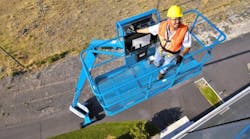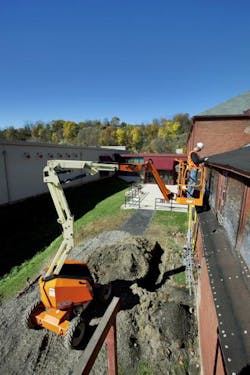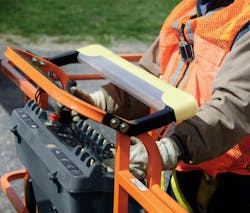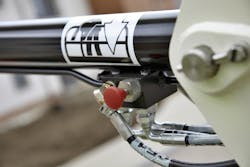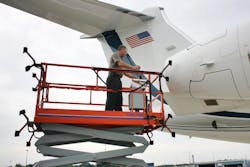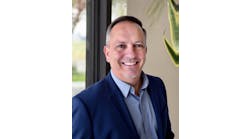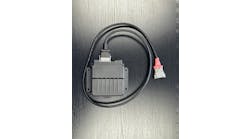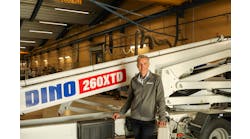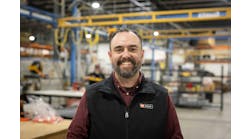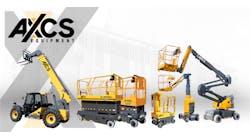Make Safety Click: Promote Use of Fall Protection Equipment with Aerial Equipment Rentals
If you grew up in the United States prior to the 1980s, you remember the days when wearing your seat belt in the car on the way to school or work was just a good idea and an extra safety measure, but was by no means required by law. Sometimes it was buried so deep between the cushions of the seat you couldn’t find it to put on even if you wanted to. But in 1984 that began to change when New York passed the first state law in the U.S. mandating the use of seat belts. Supported by growing research that showed the life-saving benefits of seat belts, other states followed by passing legislation and by 2007 all 50 U.S. states, with the exception of New Hampshire, had laws making it an offense to not wear a seat belt in the front seat of a vehicle. Today it has become a habit most of us don’t even think about.
The aerial equipment industry has some parallels to the automotive industry. Original equipment manufacturers have always sought to develop the safest equipment possible, but the importance of proper aerial work platform training, machine familiarization, pre-start inspections, workplace risk assessment, personal fall protection and selection of the appropriate machine for the job are all facets of an overall safety plan that have gained increasing attention and reverence during the past decade as the popularity of aerial equipment has boomed. Awareness of safety in the use of AWPs has grown and the right habits continue to click across the industry.
Industry organizations such as American National Standards Institute and Occupational Safety and Health Administration exist to develop and enforce safety rules and regulations that keep workers safe on the jobsite. But rental companies and industry organizations such as the International Powered Access Federation and American Work Platform Training, Association of Equipment Manufacturers, American Rental Association, Associated Equipment Distributors and Scaffold Industry Association have come together in recent years to advance the safe use of aerial equipment. Together, these organizations have created three best practices documents to increase awareness of best practices, clarify responsibilities and address the safe use of AWP equipment.
The latest, Statement of Best Practices for Workplace Risk Assessment and Aerial Work Platform Equipment Selection, was developed to aid in the identification of workplace hazards, offer guidance for conducting a thorough workplace risk assessment and implementing control measures, and assist in the selection of the most appropriate AWP equipment for the work required. This document clearly defines the steps necessary to identify potential workplace hazards prior to the beginning of any work and the subsequent steps to mitigate those hazards to create a safe working environment. The industry has done much to raise awareness of the best practices for safe use of aerial equipment. Collectively, the equipment manufacturers, rental companies, contractors and operators have the responsibility to take the safety information available to them and make it part of the workplace culture.
Jeff Stachowiak, director of safety training for Sunbelt Rentals, sees an opportunity for the rental industry to serve as an ambassador for fostering this safety culture with aerial equipment users. “With the move towards rental and away from ownership, the rental industry is the key to get safety information and safety improvements back to the manufacturers,” Stachowiak says.
Facts of fall protection
Another collaboration published by the industry’s organizations in February 2011 is the Statement of Best Practices of Personal Fall Protection Systems for Aerial Work Platform Equipment, which was completed to serve as a general guide for basic fall protection and provide best practices for its use with AWP equipment. It is also intended to provide an overview of OSHA regulations and ANSI aerial lift standards that define fall protection requirements when using AWP equipment.
Like seat belts, personal fall protection equipment can save lives and improve the safety of the aerial equipment when it is worn. PFP equipment is designed for use in a wide variety of applications and with a wide variety of aerial equipment. It should meet all applicable OSHA and ANSI regulations and be easy to don, comfortable to wear and should not inhibit the user from doing his or her job once at height.
A fall-protection system includes the anchorage, a body belt or harness, and a lanyard that connects the two. A lanyard for fall arrest should include an energy (shock) absorber.
“Personal fall protection equipment used for a fall protection system has to take into account the location of the anchorage on the AWP as designed by the AWP manufacturer to determine if fall restraint is possible, or a fall arrest system must be used,” explains Tony Groat, International Powered Access Federation North American manager and Aerial Work Platform Training executive vice president.
Tom Dillon, North American market development manager for Honeywell Safety Products, makers of Miller Fall Protection equipment, suggests several factors to consider when deciding which type of PFP system should be used on a job: Where is the attachment point for the anchorage connector — above your head, below your waist, below your feet? At what height will you be working? Is that height constant or will you be adjusting the height as you work? What is the clearance distance you have? Does that distance change as you work? Do you need to move around to accomplish your task or it is a stationary position the entire time?
“These same questions need to be reviewed and answered and the operator may need to change what type of personal fall protection system they are using, based on the answers they have for each location,” Dillon says.
While the industry best practices document outlines the different types of systems to choose from for use with different types of AWPs, partnering with a PFPE provider ensures that operators are pairing the appropriate safety gear with the equipment on their jobsite.
“Many manufacturers of fall protection products are available to help set up your fall protection program, assist with appropriate equipment selection, and train on proper usage,” says Jeff Martin, senior product manager – hard goods, Capital Safety.
Since fall protection equipment is sold independently from AWPs, there is often some confusion about whose responsibility it is to provide the PFPE to users. The OSHA standard for personal fall protection requires employers to provide PFP equipment and to ensure that it is used properly. Simply put, it is the responsibility of the employer to the employee who is exposed to the hazard to provide that personal fall protection equipment, Sunbelt’s Stachowiak explains. As such, rental companies that offer AWP for rent in their fleet must provide PFPE to its employees.
Industry safety expert, Groat, concurs. “Fall protection is an employer responsibility. It includes a fall protection plan that addresses training, inspections, proper use and rescue plans. A rental company must have a plan for themselves as drivers, mechanics, sales and others are operators of the equipment and have fall protection responsibilities. This should demand their expertise on the topic as users of all their AWP equipment. It is the employers’ responsibility to provide, but a rental company should offer the information for the requirements of safe use of their products and an option for their customers to meet that (purchase or rental).”
Chicago-area aerial rental specialist Metrolift Inc. fosters a culture where its employees must know every aspect of fall protection as it relates to its equipment.
“As a rental company owner I always remember that my employees are also operators of this equipment,” says Rick Dahl, Metrolift president. “My mechanics inspect and operate every piece of equipment prior to it being delivered. My drivers load and deliver every piece of equipment. We familiarize our customers on how to use the unit upon delivery. We want to set the example that safety is priority one. Since we are often the first person to touch any given lift, we have instituted a policy where fall protection is to be worn at all times on any piece of aerial equipment. This exceeds OSHA standards, but it really takes the guess work out of when/if you should use fall protection.”
United Rentals recognizes its responsibility to take the necessary steps to protect its employees who operate AWP equipment as well. The company evaluates the risks facing employees and implements the right preventive measures to protect its workers. “Fall protection is just one aspect of a complete operator safety program,” explains James Dorris, vice president of Health, Safety, Environment & Sustainability for United Rentals.
Customer safety
Rental companies are not required to sell, rent or otherwise provide PFP equipment with an AWP rental since it is the responsibility of the operator’s employer to do so. However, if a rental company DOES elect to offer it as a rental item, that rental company takes on the responsibility to offer training on use of the PFP equipment and to inspect it. As Groat explains, if the rental company is renting AWP equipment to homeowners, then there is not an employer mandated to supply PFPE and the rental company must evaluate the risk of renting it to them versus them not using any PFPE on their job.
“Rental companies are in the business and will be perceived to be the experts,” Groat says. “The ANSI standards make it a responsibility of the dealer (rental company) in section 5.10 to ‘assist owners and users.’ Awareness of the responsibility for the operator to wear PFPE on boom-type AWPs and perhaps an offering of a PFP system that is an appropriate option for the equipment being supplied would be reasonable.”
Most rental businesses interviewed by RER for this article noted that they do offer personal fall protection equipment to customers. True, many renters of AWPs already have (and should) a safety program and the correct safety equipment in place, making additional supplies at the time of the rental unnecessary, notes Honeywell’s Dillon. “On the other hand, if a user does not have the proper safety equipment it should be available.”
“Many rental companies believe it is necessary that they provide the proper safety equipment to renters in order to assure the user is both compliant and protected when using the lift,” says Capital Safety’s Martin. “But beyond just providing the right equipment, training on how to properly use it is also essential. Fall protection equipment does not have to be cumbersome or difficult to use. Selecting the proper equipment can make training easier and more effective.”
Sunbelt’s Stachowiak believes that the rental company can help educate the customer on the training requirement prior to operating a lift and that proper fall protection or restraint should be covered in the training. “We train our customers to understand the forces at play when operating a boomlift and the resulting catapult effect and that they need to use a harness and lanyard system that will prevent the occupants from leaving the platform should they be catapulted,” Stachowiak says.
Metrolift’s Dahl believes that all lift companies should have fall protection available to their customers. “A majority of the time our customers have their own fall protection. On the occasions where we have new operators working on equipment we want them to know what is required and that it is available.”
Dahl has noticed the trend on many jobsites to exceed OSHA’s standards of fall protection equipment. “Many jobsites are now requiring fall protection on every piece of aerial equipment every time is it being used. I like the increased [jobsite] requirements because it brings additional awareness to the potential dangers of aerial equipment.”
Caterpillar dealer and Cat Rental Store, Wagner Rents, takes the safety of its employees and customers very seriously, even marketing itself as a safety resource to customers on social media such as Twitter. “At a minimum, rental companies should stock fall protection to offer customers to purchase for aerial rentals,” says Wagner Rents’ regional operations manager Ray Nibbe. “Wagner Rents stocks an inventory of fall protection at all of our rental outlets and we suggestively sell fall protection when reserving aerial equipment for rentals.
“Fall protection should be part of any rental company’s safety culture. This includes customers, employees, vendors and anyone operating one of your AWPs. As an industry, we play a role in the education and safety of our customers.”
Safety under development
OEMs continue to develop safer equipment and offer added safety features as standard equipment. In addition, safety accessories designed for specific applications are becoming more readily available that can significantly improve the safety of the AWP operator.
JLG Industries recently introduced the SkyGuard aftermarket accessory to provide enhanced control panel protection for boomlifts. Developed in cooperation with feedback from end users and rental companies, SkyGuard is activated when 50 pounds of force is initiated on the sensor from one of a variety of angles, stopping all functions. The control system automatically accesses the functions in use by the operator at the time of SkyGuard activation, and is able to reverse that sequence for a small period of time, with the exception of certain functions.
“We constantly look for ways to improve our existing safe product designs and to provide value to our customers,” says Jeff Ford, JLG global product director. “We will continue to listen and work with our industry partners in an effort to fulfill our ongoing commitment as an industry leader in product safety.”
Wagner Rents’ Nibbe commends OEMs for their efforts to continually improve safety of their AWPs, specifically citing Genie’s Operator Protective Structure, a prototype designed to provide additional protection to the operator in some applications where overhead crushing hazards may exist. The tubular-steel OPS structure is engineered to transfer kinetic energy into surrounding structures while maintaining a protected volume for the operator.
In addition to its OPS prototype, Genie developed the Padded Aircraft Protection Rail System for the Genie GS 2646AV scissorlift as a way for workers in the aviation industry to work safely at height and to provide protection for the aircraft. The PAR system uses closed cell foam padding on the scissor platform rails, giving an extra layer of protection against aircraft damage during manufacture and maintenance.
Most recently, Terex introduced the Genie Lift Pro Online Operator Training program, which is designed to satisfy the general training requirements for aerial work platforms as defined by ANSI, OSHA and Canadian Standards Association.
“By offering this course online, a much broader range of individuals will have access to the opportunity to become a qualified operator, and a wider range of Genie customers who don’t currently offer this type of program will have the ability to provide high-quality operator training to their end users,” says Jeff Weido, Terex AWP marketing director. “By increasing the percentage of operators who have received quality training through this program, we are all contributing to the improvement of overall aerial work platform industry safety.”
AWP maker Snorkel offers a number of standard safety features on its lifts, including tilt and drive motion alarms, sustained pressure-enabled foot or toggle switches and emergency lowering systems, along with optional descent and elevation alarms. Though the company does not offer any accessories to prevent crushing by overhead obstacles, it does work with rental companies and other customers to develop these added safety features.
“We are currently working with a rental company that has created its own crush prevention system to ensure this accessory can be properly and safely integrated onto our boomlifts,” says David Smith, Snorkel North America CEO. “At the moment we are taking this on a case-by-case basis; we will work with any customer to ensure that they can safely fit anti-crush devices to our booms if they wish to do so.
“Snorkel is reviewing future projects involving improved electronic and physical guarding of controls, many of which are also being pushed in other areas of the world, but may be advantageous for products sold in North America.”
Sunbelt’s Stachowiak calls any advancement developed to help save lives a plus. “The rental industry should be working hard with the manufacturers to develop these types of safety devices and continued improvements. As well, manufacturers need to look outside their own companies for ideas and devices that will help the whole industry.”
Man Lift Mfg. Co. is one such company that works with OEM’s aerial equipment to make it safer and better suited to a specific application. It often develops products in response to challenges that its customers and the industry as a whole are experiencing. Examples include open-face boom baskets with two-person fall arrest systems and providing electrically insulated lifts to meet the needs of industries such as tree care.
Man Lift Mfg. created and brought to market a product called Proxy Shield, a collision-avoidance system that uses photo eye arrays to warn operators and shut down equipment when an obstacle enters the path or a collision is imminent. Proven to be effective in preventing damage to aircraft and other equipment, Proxy Shield is also designed to prevent worse harm to operators.
“The system will recognize when there is an obstruction and will shut down the lift,” explains Man Lift president and CEO Phil Spiro. “This is extremely important protection and will protect operators and equipment from crushing injuries. The technology can be deployed on existing equipment as well as new, and is robust and reliable due to its simplicity.”
Fall fatalities from AWPs are preventable. Industry organizations, rental companies and contractors continue to work together to advance the overall safety of the aerial equipment industry. The good news is, adherence to best practices for the advancement of safety in the aerial equipment industry is clicking.
ABCs of Fall Protection
Anchorage – The anchor point that is the secure point of attachment in the lift.
Body Support – A full body harness.
Connector – A device, such as an energy-absorbing lanyard or self-retracting lifeline that links the wearer’s full body harness to an anchorage point.
Decent/Rescue – Used to retrieve or lower a fallen worker to the ground.
*All of the components used should be ANSI and OSHA compliant
